How Window Tinting Enhances Your Car's Appearance and Protects Its Interior
Wiki Article
Window Tinting Regulations: What You Required to Know Before Tinting Your Automobile
Understanding home window tinting legislations is vital for any type of automobile proprietor taking into consideration tinting their cars and truck. Regulations differ considerably from one state to another, establishing specific limits for Visible Light Transmission (VLT) percents, particularly for front-side home windows and windshields. Failure to abide with these laws can cause penalties, the need to get rid of the tint, and problems with insurance. As you ponder enhancing your vehicle's appearance and performance, it is crucial to grasp not only the legal ramifications but also the practical factors to consider that include choosing the ideal color. What variables should you prioritize in your decision-making process?Value of Comprehending Tint Rules
Comprehending window tinting laws is essential for vehicle owners to ensure conformity with state policies. These legislations dictate the acceptable degrees of tint darkness and reflectivity, which can considerably vary from one territory to another. Falling short to abide by these regulations can cause penalties, mandatory elimination of the color, and potential issues throughout vehicle examinations.Moreover, recognizing these regulations aids lorry proprietors make notified choices concerning their tinting choices. Various kinds of window movies offer different benefits, such as UV defense, warmth denial, and glow decrease. However, without expertise of the legal restrictions, lorry owners take the chance of choosing items that might inevitably bring about lawful issues.
Additionally, recognition of tinting regulations fosters a much safer driving environment. window tinting. Exceedingly dark colors can impair visibility, increasing the threat of mishaps, particularly at evening or in negative weather conditions. Police also use these guidelines to ensure roadway safety, making conformity not simply a personal duty yet a legal commitment
State-Specific Color Regulations
Each state in the united state has actually established its own details regulations relating to home window tinting, showing a diverse selection of demands and criteria. These regulations can vary significantly, influencing exactly how car proprietors approach installation and conformity. For instance, some states enable darker colors on back home windows while enforcing strict limits on front-side home windows.In addition, policies typically define allowable color products and shades. Certain states prohibit reflective colors altogether, while others might permit them to a limited level. Additionally, some jurisdictions mandate that lorries with colored home windows show a sticker suggesting compliance with state regulations, offering a clear recognition for police.
Enforcement of these laws likewise varies; some states are extra positive, carrying out random checks, while others rely upon grievances or noticeable offenses to launch enforcement. Car proprietors must understand that failure to abide by state-specific tint regulations can lead to fines, mandatory removal of unlawful colors, or both.

Legal Color Percentages
Figuring out the legal tint percents is vital for automobile proprietors seeking to abide by state regulations. Each state has certain regulations governing how much light must pass with the home windows of an automobile, which is expressed as a portion called Noticeable Light Transmission (VLT) This portion differs considerably across states and can depend upon the kind of home window-- front side, rear side, and windscreen.For circumstances, some states allow just 20% VLT on front side home windows, while others may permit up to 50%. Windscreen tinting is typically more limited, with lots of jurisdictions allowing just a slim band of tint at the top of the windscreen. On the other best site hand, back home windows generally have a lot more lenient policies, with some states permitting darker colors.
It is crucial for car owners to acquaint themselves with their regional legislations to stay clear of prospective legal problems. This includes understanding just how VLT is determined, as it can vary based on the kind of window film made use of. Remaining educated about these laws guarantees compliance and promotes risk-free driving conditions for both the car owner and others on the roadway.
Consequences of Non-Compliance
Failing to adhere to window tinting legislations can lead to significant consequences for vehicle owners. Police officers educated to recognize prohibited tint levels may provide penalties, which can differ by territory yet frequently range from moderate to significant quantities.
Insurance companies might additionally impose charges for non-compliance, as prohibited adjustments can be considered as a breach of plan terms. This could affect protection rates or lead to complications in claims if an incident occurs.
Eventually, the consequences of non-compliance extend past instant monetary fines; they can influence a motorist's insurance coverage prices, legal standing, and overall automobile worth, emphasizing the importance of sticking to local home window tinting guidelines.
Tips for Picking Tinting Options
When selecting window tinting options,Comprehending the effects of non-compliance highlights the significance of making educated choices. Acquaint on your own with your state's particular legislations pertaining to tint darkness and reflectivity. Each state has one-of-a-kind laws that dictate the permitted restrictions, so ensure you remain within these standards to stay clear of fines.Second of all, take into consideration the sort of tint material. Options include colored, metalized, and ceramic colors, each offering varying degrees of heat being rejected, UV defense, and longevity. Continue For circumstances, ceramic tints offer remarkable navigate to this website warmth resistance without disrupting digital devices, making them a prominent selection.
Additionally, examine your main function for tinting. If you look for improved personal privacy, choose darker tints; however, bear in mind that this may impact visibility in the evening. On the other hand, if glare decrease and UV security are your primary problems, lighter tints might be sufficient.
Finally, talk to a professional installer who is educated regarding regional guidelines and can suggest premium materials suited to your needs (window tinting). Taking these factors right into account will guarantee you make a well-informed choice, ultimately enhancing both your vehicle's aesthetic appeals and performance
Verdict
In verdict, experience with window tinting laws is essential prior to applying color to an automobile. By recognizing lawful needs and picking proper color materials, lorry proprietors can achieve visual improvement while staying compliant with pertinent laws.Recognizing home window tinting legislations is essential for any kind of lorry proprietor taking into consideration tinting their auto.Understanding window tinting legislations is critical for automobile owners to make sure conformity with state guidelines. Some states permit darker tints on rear windows while imposing rigorous limitations on front-side home windows.
In comparison, back windows usually have a lot more forgiving policies, with some states allowing darker tints. (window tinting)
In final thought, familiarity with home window tinting legislations is vital prior to applying color to a car.
Report this wiki page